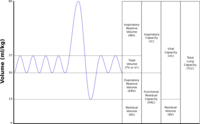
Photo from wikipedia
Type of funding sources: Private grant(s) and/or Sponsorship. Main funding source(s): Stiftung KinderHerz Weserstr. 101 45136 Essen. For the last decades, surgical progress lead to better functional outcomes in patients… Click to show full abstract
Type of funding sources: Private grant(s) and/or Sponsorship. Main funding source(s): Stiftung KinderHerz Weserstr. 101 45136 Essen. For the last decades, surgical progress lead to better functional outcomes in patients with congenital heart defect (CHD), which may also affect lung function. Reduced lung volumes were found in about half of all patients with a CHD. This prospective study investigated lung function with spirometry and body plethysmography in children with CHD. Data reported were FVC, FEV1, and its ratio (spirometry), together with total lung capacity (TLC), and residual volume, presented as its ratio to TLC (RV/TLC) from body plethysmography. From April 2018 to October 2022 fifty-eight young patients (14.0 ± 2.5 years, 16 girls) with CHD participated in the study. Their results are presented as z-scores, sticking to the latest Global Lung Initiative reference values (2021). Values of z-scores <-1.645 in FVC, normal FEV1/FVC-z>-1.645, and a reduced TLC (z<-1.645) represent a restrictive pattern. A reduced FVC-z<-1.645, normal FEV1/FVC-z>-1.645, and an increased RV/TLC-z>1,645 represent a non-specific pattern. FEV1/FVC-z <-1.645 represent an obstructive pattern that can be approved with an increased RV/TLC. Results in FVC-z were -1.0 ± 1.3, FEV1-z -1.0 ± 1.2, and its ratio 0.0 ± 1.0. TLC-z was -0.4 ± 1.1 and RV/TLC-z reached 0.7 ± 0.7. Sixty-seven percent had normal results. However, 33% had a reduced FVC in spirometry. Only three patients showed decreased FEV1/FVC ratio. However, only five children show restriction (TLC<-1,645), representing 9% of all investigated patients. Still, about one-third of children with CHD show striking results in lung volumes. Although studies suggest better results in nowadays patients, children’s lung function with spirometry and body plethysmography should be tested regularly in children with congenital heart disease. Since lung function is trainable, these patients might benefit from early diagnosis.
Journal Title: European Journal of Preventive Cardiology
Year Published: 2023
Link to full text (if available)
Share on Social Media: Sign Up to like & get
recommendations!